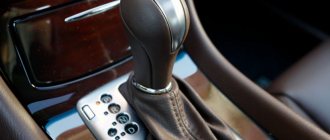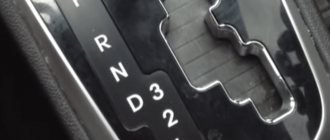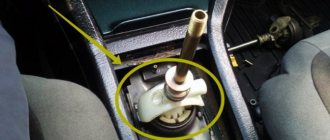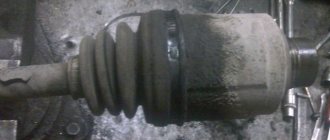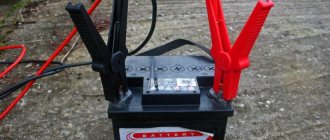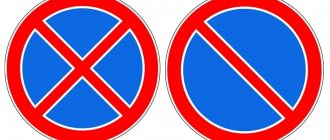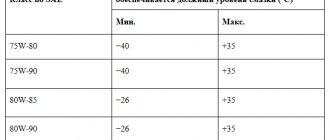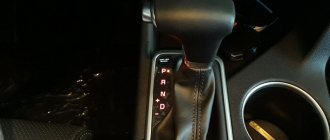The neutral gear on an automatic transmission technically performs the same function as on a conventional manual transmission, that is, it separates the engine and transmission so that torque is not transmitted to the wheels and the car cannot move while the engine is running. However, the functionality of neutral on an automatic transmission compared to a manual transmission is very limited; basically this mode is designated by the letter N
(Neutral), used when towing a car or any other service transportation.
Also, the automatic transmission can be put in neutral during long-term parking or parking with the simultaneous use of the parking brake (handbrake), but in such cases it is still much more convenient to use the special P
(Parking) mode.
Neutral on automatic while driving
Is it possible to coast with an automatic transmission in the same way as a manual, including neutral at speed, especially during a long descent, in order to relieve the engine and save fuel? It is absolutely IMPOSSIBLE to do this, so as not to “kill” the box ahead of time. More precisely, it is still possible to throw it into neutral while driving without any damage to the unit, but when the handle returns to the D
(Drive) driving mode, the gearbox mechanism is subjected to a serious shock when the friction discs of the input and output shafts, rotating at different speeds, are closed.
If the machine accidentally switches to position N
, before returning it to
D
, you should release the gas and reduce engine speed in order to at least slightly synchronize the speeds of the shafts.
To this we can add that in the case of a classic automatic transmission, when you release the gas pedal at speed, the so-called engine braking effect does not appear as noticeably as with conventional mechanics, since the oil damper does not allow the box to be unduly loaded when the engine speed decreases, thereby protecting its mechanism from damage. That is, there is practically no point in turning on neutral while driving; the car, in fact, will almost coast anyway.
Neutral gear on an automatic transmission. Traffic light, traffic jam, roll-on | Lesson 5 AUTOMATIC
Today is the fifth video lesson on driving an automatic transmission (automatic transmission). I propose to talk about such an important aspect as neutral transmission. It seems like what to say about her? But it’s not so simple, many drivers who drive a manual transmission can often coast the car (neutral at speed), but is this possible with an automatic? Or here’s another question: is it necessary to switch to neutral at a traffic light? And in general, why do we need this automatic transmission...
THE CONTENT OF THE ARTICLE
First, a little definition.
Neutral gear is the position of the gearbox (not only automatic, but also manual ) in which torque from the engine is not transmitted to the wheels, thus the car does not move when the engine is running.
Do I need to put the automatic in neutral at traffic lights?
As we already know, when neutral gear is engaged, the machine has no connection between the input and output shafts. However, an automatic transmission, unlike a manual transmission, has a rather complex clutch principle, the function of which is performed by a torque converter. When the lever is moved to position D,
the pump forces transmission fluid into the valve body, a special solenoid valve opens, distributing fluid pressure to the friction discs of the gears that connect both shafts, and the car is ready to move.
That is, if during a short stop the machine is switched to neutral and then back to mode D
, then this complex process will be repeated twice, which leads to increased wear of the solenoids and clutches of the first gear and, as a consequence, to early expensive repairs.
Therefore, when stopping at a traffic light or any other short-term parking without turning off the engine, the automatic transmission should be left in mode D
, taking your foot off the gas pedal while holding the car using the brake pedal.
When standing for a long time, for example, in a traffic jam or in line for gas, in order not to hold the brake for a long time, and also to save a little fuel, it is best to completely turn off the engine and put the gearbox in position P
, as in normal parking.
Automatic transmission modes
Before we begin to understand the essence of neutral on an automatic transmission, let’s remember what gears exist in modern automatic transmissions.
In most modern car models with an automatic transmission, there are 5 positions, marked with letters on the operating panel next to the selector lever.
- The main position of the gear selector in automatic transmission, which ensures the vehicle moves along the road, is D, or Drive;
- Parking position – P stands for Turns on when the vehicle stops;
- Neutral mode N, or Drivers nicknamed it neutral. We will talk about it in more detail below.
- Reverse gear is marked with the letter R, which means Reverse.
- OVERDRIVE transmission, marked on the panel with the letters O/D. Not available at all checkpoints. On five-speed automatic transmissions, overdrive can be turned off by simply pressing the button.
Read
Selecting and installing a multilock on an automatic transmission yourself
Towing a car automatically
As noted above, towing can only be done in position N
, and the towing range and speed limits specified in the vehicle’s instructions should be adhered to. If these are not specified, then the 50/50 formula is usually used, that is, the towing range should not exceed 50 km and the speed should not exceed 50 km/h. If these limits are exceeded, individual moving elements of the box may jam due to a lack of lubrication when the pump is not working (the transmission fluid of an automatic machine, in addition to the motor fluid, has a lubricating function).
If it is possible to start the engine of a faulty car, it is worth doing this while towing, since the engine will force the transmission fluid pump to work, which will provide the machine with proper lubrication. If the engine does not start, but the starter is working, turn the starter every 10-15 minutes to activate the pump at least for a short time. If you need to transport your car over a long distance, it is best to use a tow truck; also, if the car is front-wheel drive, then it can be towed with the front wheels raised; for a rear-wheel drive car, the driveshaft can be disconnected from the box.
In conclusion, we also note that although automatic transmissions, in addition to classic torque converter boxes, have such varieties as robot and variator, which differ significantly in their design, all of the above rules are equally applicable to them.
What modes are there on automatic transmission?
Before we talk about why a neutral gear is needed on an automatic transmission, you should study all the available modes.
Depending on the specific automatic transmission, the set of modes may be different. But there are the same ones for all cars.
Most often, on modern automatic machines there are 5 positions on the automatic transmission panel. It is between them that the driver selects the desired one by operating the selector:
- Drive mode. Or simply the letter D. It is considered the main position, because when it is selected, the car begins to move forward.
- P or parking mode. The need for Parking mode is easy to explain. This is a necessary position if the car stops and the driver leaves the cabin.
- R or Reverse. Another necessary mode. This position is responsible for the ability to reverse. That is, this is reverse gear, if you can call it that.
- This is neutral. The main material will be dedicated to her.
- Overdrive or letters O/D. It is not present on all automatic transmissions, but it occurs quite often. Has several purposes. It is recommended to turn on overdrive if you need to overtake a car at speeds of more than 100 km/h, tow a trailer, or drive off-road. In essence, this is an overdrive gear, which is an analogue of 5th speed on a manual transmission.
As you can see, all the considered modes, except neutral, have important functions and purposes. But regarding the tasks of position N, a lot of controversy and conversation arises.
This is interesting: What is the ground clearance of the car?
Why is neutral gear needed in an automatic transmission?
Many drivers of cars with an automatic transmission may never shift to neutral during their entire operation. Despite this, neutral gear (or another automatic transmission mode that simulates it) must be present in the gearbox. This is necessary for towing the car.
If you read the service manual for a vehicle with an automatic transmission, you will find information about how to tow your vehicle. Manufacturers recommend that when towing, engage the towed vehicle with an automatic transmission in neutral gear and drive at a speed of no more than 50 kilometers per hour. At the same time, most often, towing recommendations also indicate that a car with an automatic transmission should not be towed further than 50 kilometers, and if it is necessary to cover a distance of more than 50 kilometers to the destination, it is better to use a tow truck or tow with the car’s drive wheels raised.
Another scenario where the neutral gear of an automatic transmission can be used is when parked. It is recommended to leave the car in neutral with the handbrake in the parking lot only in cases where there are problems with the operation of the parking mode - P. It is worth noting that if the car is in neutral, you will need to depress the brake pedal to start the engine.
What not to do with automatic transmission
Automatic transmission repair specialists keep statistics on the causes of breakdowns. There are bad designs, but more often the drivers are to blame. An automatic transmission lasts longer with caring owners who change the oil according to regulations and follow the rules of vehicle operation. You can read about this in the technical manual.
| What not to do with an automatic machine | Consequences |
| Drive a cold car | Insufficient lubrication, cooling. There are kicks and pushes. |
| Slip on mud, ice, deserts, off-road. | The gearbox overheats due to prolonged wheel slipping |
| Tow trailers that exceed the permissible weight | The machine overheats and wears out quickly. |
| Tow a car without following the speed and distance rules | Towing further than 30 - 50 km can lead to overheating of the automatic transmission. With a broken engine, the automatic transmission will not be able to operate. |
The main rule on how to operate an automatic transmission is to avoid sudden acceleration, braking, and turns. Due to high load, gaps in automatic transmission units change, scuffing appears, and friction increases due to lack of lubrication. It becomes uncomfortable to control the transmission. The box begins to twitch, delays or dips appear in switching. In this case, you will have to sort out the machine.
Towing a car
There is an opinion that it is impossible to tow an automatic vehicle. And here we can practically agree. However, it is still possible to do this, but there are many restrictions. First of all, this cannot be done at a speed of more than 50 km/h. If this rule is not followed, then after 10 kilometers of towing you may face serious problems. Unfortunately, some drivers learn about this very important nuance after they have towed the car a decent distance. However, it is best to read the manuals of a specific model, since some cars with an automatic transmission are strictly prohibited from towing.
It is worth remembering that long-term towing is prohibited with an automatic transmission. Therefore, it is best to transport it with a tow truck if there are any problems.
N must be included
Meanwhile, robotic boxes are structurally different, so the operating rules for them are special. The robot does not have planetary gears along with a complex system of mode switching. This box is a mechanical transmission with a clutch package, which is controlled electronically. When you press the brake, the clutch discs move apart, releasing torque. When sitting idle in a traffic jam, the clutch cannot be kept open for a long time, the clutch pack overheats, the load on the mechanics of the unit increases, bearings and other structural elements wear out.
Therefore, the robotic transmission must be set to neutral during stops of more than 2 minutes in order to extend the life of the clutch discs, as is done with a manual transmission.
In general, if your car has a hydromechanical automatic transmission with a torque converter, then shifting the transmission during short stops in traffic jams is not necessary and even harmful.
However, a robotic transmission requires the use of neutral.
What is an automatic transmission
An automatic transmission is one of the types of transmission in which the required gear ratio is automatically selected without driver intervention, taking into account the nature of the movement, speed and other parameters.
In a car with an automatic transmission, there is no clutch pedal due to the fact that the clutch is replaced by a torque converter, which transmits torque to the wheels.
Starting a car with automatic transmission
To ensure the safety of the automatic transmission, several types of protection are provided in the car.
To start the car engine, the selector lever must be in the Parking (P) or N eutral (N) position. When the selector is in other modes, starting the engine will be impossible, since either the key will not turn or nothing will happen at all.
Due to the fact that the “N” mode is intended by the manufacturer mainly for towing the car, it is preferable to use the “P” mode to start the engine, in which the drive wheels are locked, which protects against unplanned movement of the vehicle on an inclined surface.
Another important protection against improper starting of the car is the need to depress the brake pedal, which is very useful when starting the car in the selector position on “N”, since the pressed brake pedal will prevent the car from rolling when it is on an inclined surface.
Modern cars have additional types of protection to prevent theft. If, despite following all the steps to start the engine correctly, the key in the ignition switch cannot be turned and the steering wheel also does not respond to attempts to turn it, the anti-theft protection has turned on.
To remove it, you must carefully turn the key while turning the steering wheel in any direction. With coordinated actions, the theft protection will turn off and the car will be able to start.
How to start automatically
After starting the engine, the car must be released from the handbrake.
To start driving with the brake pedal depressed, you must move the selector to one of the positions by pressing the button on it:
- “D” - forward movement under normal conditions;
- “R” - reversing if maneuver is necessary;
- “L” or “D2” - for off-road driving, when the car is on a significant slope at the moment it starts moving, the maximum permitted speed for such modes is less than 40 km/h;
- “D3” - if necessary, move down a small hill;
- “S”, “W”, “*”, “Hold”, “Winter” - winter mode, for starting and driving on snow with a reduced probability of slipping of the drive wheels.
After releasing the brake pedal, the car will begin to move even without pressing the accelerator (gas) pedal.
In severe frosts, before driving after a long period of parking in a cold place, it is necessary to allow the engine and transmission to warm up for 6-10 minutes.
How to brake with an automatic engine
With automatic transmissions, you can use engine braking, but this process differs from manual transmissions.
To apply engine braking, depending on the conditions, you must select the following selector positions:
- if there is an “O/D” button at a speed below 110 km/h, it can be pressed to smoothly brake the engine and limit the speed to 80 km/h;
- “L”, “D1” or “D2” when driving off-road with descents and ascents at a large angle, these modes allow you to use maximum power and limit the speed to 20-50 km/h (L, D1), 40-80 km/h h(D2);
- “D3” - movement up to 3rd gear at speeds up to 100-110 km/h;
How to use the handbrake
The manufacturer indicates that it is necessary to use the parking brake even in the selector position “P”
The main points for using the handbrake are:
- the need for additional securing of the car when parked with the engine running, especially when leaving the vehicle;
- the need to securely secure the vehicle in case of installing a spare wheel and other minor repairs;
- when stopping on a surface with a large inclination angle to avoid the selector being knocked out of the “P” position due to the heavy load on the drive wheels.
Before starting to drive, it is necessary to check the parking brake to avoid trying to start driving with the parking brake applied.


